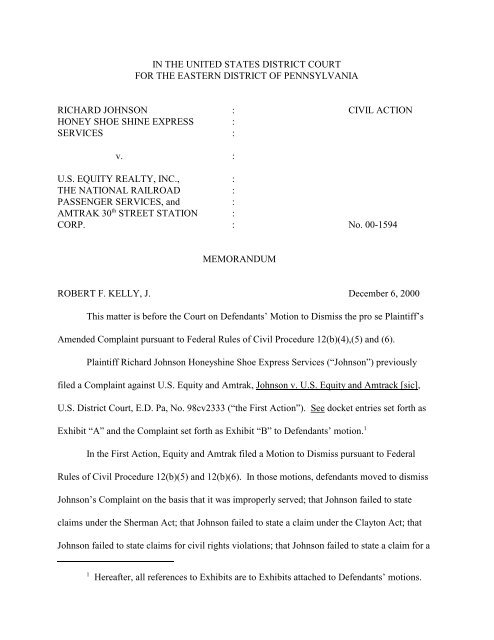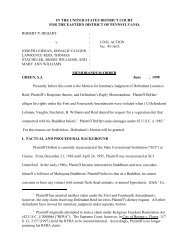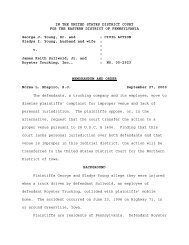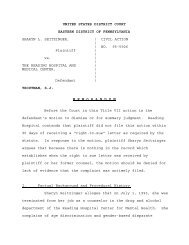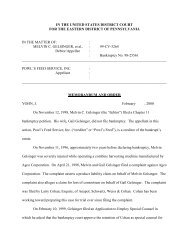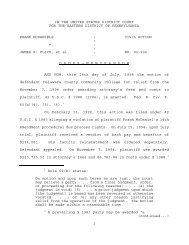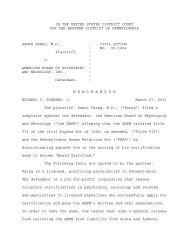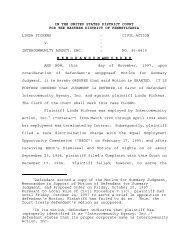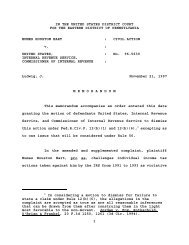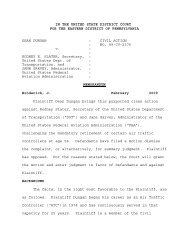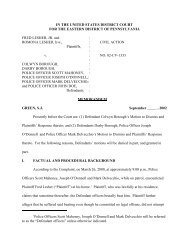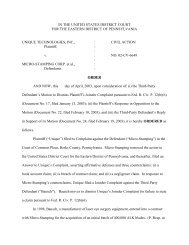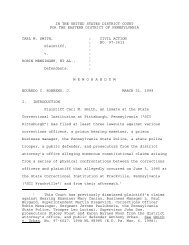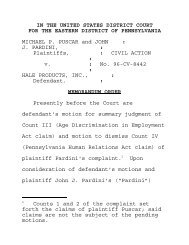1 Hereafter, all references to Exhibits are to Exhibits attached to ...
1 Hereafter, all references to Exhibits are to Exhibits attached to ...
1 Hereafter, all references to Exhibits are to Exhibits attached to ...
You also want an ePaper? Increase the reach of your titles
YUMPU automatically turns print PDFs into web optimized ePapers that Google loves.
IN THE UNITED STATES DISTRICT COURT<br />
FOR THE EASTERN DISTRICT OF PENNSYLVANIA<br />
RICHARD JOHNSON : CIVIL ACTION<br />
HONEY SHOE SHINE EXPRESS :<br />
SERVICES :<br />
v. :<br />
U.S. EQUITY REALTY, INC., :<br />
THE NATIONAL RAILROAD :<br />
PASSENGER SERVICES, and :<br />
AMTRAK 30 th STREET STATION :<br />
CORP. : No. 00-1594<br />
MEMORANDUM<br />
ROBERT F. KELLY, J. December 6, 2000<br />
This matter is before the Court on Defendants’ Motion <strong>to</strong> Dismiss the pro se Plaintiff’s<br />
Amended Complaint pursuant <strong>to</strong> Federal Rules of Civil Procedure 12(b)(4),(5) and (6).<br />
Plaintiff Richard Johnson Honeyshine Shoe Express Services (“Johnson”) previously<br />
filed a Complaint against U.S. Equity and Amtrak, Johnson v. U.S. Equity and Amtrack [sic],<br />
U.S. District Court, E.D. Pa, No. 98cv2333 (“the First Action”). See docket entries set forth as<br />
Exhibit “A” and the Complaint set forth as Exhibit “B” <strong>to</strong> Defendants’ motion. 1<br />
In the First Action, Equity and Amtrak filed a Motion <strong>to</strong> Dismiss pursuant <strong>to</strong> Federal<br />
Rules of Civil Procedure 12(b)(5) and 12(b)(6). In those motions, defendants moved <strong>to</strong> dismiss<br />
Johnson’s Complaint on the basis that it was improperly served; that Johnson failed <strong>to</strong> state<br />
claims under the Sherman Act; that Johnson failed <strong>to</strong> state a claim under the Clay<strong>to</strong>n Act; that<br />
Johnson failed <strong>to</strong> state claims for civil rights violations; that Johnson failed <strong>to</strong> state a claim for a<br />
1<br />
<strong>Hereafter</strong>, <strong>all</strong> <strong>references</strong> <strong>to</strong> <strong>Exhibits</strong> <strong>are</strong> <strong>to</strong> <strong>Exhibits</strong> <strong>attached</strong> <strong>to</strong> Defendants’ motions.
violation of his Fourteenth Amendment due process rights; that Johnson failed <strong>to</strong> state claims for<br />
breach of contract, conversion and wrongful interference with contract. On September 30, 1998,<br />
this Court entered an order dismissing Plaintiff’s Complaint pursuant <strong>to</strong> Federal Rules of Civil<br />
Procedure 12(b)(6) and 12(b)(5). A copy of that Order is set forth in Exhibit “E”.<br />
Johnson filed a new Complaint on March 28, 2000, eighteen (18) months after the<br />
original action had been dismissed. That Complaint was never served. Plaintiff then filed an<br />
Amended Complaint on July 14, 2000. The Amended Complaint <strong>all</strong>eges that Plaintiff is Richard<br />
Johnson Honeyshine Shoe Express Services. (Amended Complaint at 1). The caption of the<br />
Amended Complaint states that the Defendants <strong>are</strong> U.S. Equity Realty, Inc., the National<br />
Railroad Passenger Services Corp., and Amtrak 30 th Street Station a/k/a 30 th Street Market.<br />
Plaintiff sent a copy of the Amended Complaint, along with a Summons issued for the original<br />
Complaint in this action, <strong>to</strong> Equity and Amtrak by express mail. The Amended Complaint and<br />
the Summons for the original Complaint, were mailed <strong>to</strong> Equity at 30 th Street Station, 30 th and<br />
market Streets, Philadelphia, Pennsylvania, 19104; and <strong>to</strong> Defendant Amtrak at 30 th Street<br />
Station, 5 th Floor South Tower, Philadelphia, Pennsylvania, 19104.<br />
The essence of Plaintiff’s current Amended Complaint appears <strong>to</strong> be that he had a shoe<br />
shine service at 30 th Street Station in Philadelphia, Pennsylvania, Amended Complaint at 2; that<br />
he had a lease that was terminated on March 14, 1997, id. at 20; that he had <strong>to</strong> make<br />
lease/rental payments because of threats of lease cancellation in December of 1996, and was also<br />
noticed with cancellation in January, February and March of 1997, id. at 36-37; that he<br />
received letters of default “requesting payment of rents on dates not with the lease agreement [,]”<br />
id, at 49; that he was <strong>to</strong>ld he had not paid his November and December 1996 rents but he stated<br />
2
that he was up <strong>to</strong> date, id. at 42; that the shoe shine service at 3oth Street Station was<br />
subsequently operated by Amtrak or some third party with which Amtrak and/or Amtrak’s agents<br />
<strong>all</strong>egedly merged, id. at 20-25, 27; that this new service operated from a different space, a<br />
space that Plaintiff <strong>all</strong>egedly had previously requested during the period of his lease, id. at 21;<br />
that Plaintiff was <strong>to</strong>ld that there was someone from New York who could pay more money for<br />
the shoeshine location, id. at 29; and Plaintiff <strong>all</strong>eges that he was placed in default on January<br />
10, 1997 id. at 52.<br />
The Amended Complaint also <strong>all</strong>eges that Plaintiff was hired by Equity for a job for<br />
Amtrak’s police in September, 1996, and was paid in November with a post-dated check. Id. at<br />
50-52. He also claims that it was misrepresented <strong>to</strong> him that someone else was the private<br />
owner of his shoeshine stand, although he had <strong>all</strong>egedly acquired this sight at 30 th Street Station<br />
as a result of abandonment. Id. at 53-56.<br />
The averments of the Amended Complaint in the present action involve the same<br />
operative facts as the Complaint in the First Action. Paragraph 1 of the Complaint in the First<br />
Action <strong>all</strong>eges that Equity and Amtrak conspired <strong>to</strong> steal Plaintiff’s business on March 14, 1997 -<br />
the same date and event <strong>all</strong>eged in the Amended Complaint; and that the business went <strong>to</strong> a third<br />
party. 2<br />
Plaintiff makes the same <strong>all</strong>egations in the First Action concerning cancellation of the<br />
lease on that date, and there being a third party who could pay a higher rent. First Action<br />
Complaint at 6. Plaintiff <strong>all</strong>eges in the First Action that the Defendants’ “preda<strong>to</strong>ry action”<br />
resulted in his loss of income and mental distress. Id. at 2. Plaintiff <strong>all</strong>eges the same<br />
2<br />
Although the paragraphs in the First Action Complaint were not numbered, we have<br />
assigned numbers <strong>to</strong> them for the purpose of clarity.<br />
3
misrepresentation concerning the ownership and abandonment of the shoeshine location. Id. at<br />
3-4. As in the Amended Complaint, the First Action Complaint claims violations of the<br />
Sherman Act, Sections 1 and 2, conversion, wrongful interference with business relations or<br />
contract, disparagement of reputation, along with the other claims described above, <strong>all</strong> of which<br />
were dismissed in the First Action.<br />
In addition <strong>to</strong> the above referred <strong>to</strong> federal court actions, Johnson also initiated an action<br />
against the Defendants in the Philadelphia Municipal Court. Johnson v. U.S. Equities Realty,<br />
Inc. and The National Railroad Passenger Corp. d/b/a Amtrak, Philadelphia Municipal Court,<br />
Statement of Claim 990521 2133. See Exhibit “M”. In that action, Johnson <strong>all</strong>eged that he<br />
entered in<strong>to</strong> a contract <strong>to</strong> rent space for his business; that he was wrongfully billed; that he paid<br />
<strong>to</strong>o much rent; that he received default notices; that his contract was terminated on March 14,<br />
1997; and that he was entitled <strong>to</strong> monies because of these events. In that action, judgment was<br />
entered for Defendants. See Exhibit “N”.<br />
Defendant first contends that Plaintiff’s claims <strong>are</strong> barred under the doctrine of claim<br />
preclusion. “Federal law of claim preclusion requires a defendant <strong>to</strong> demonstrate that there has<br />
been (1) a final judgment on the merits in a prior suit involving (2) the same parties or their<br />
privies and (3) a subsequent suit based on the same cause of action.” The Lubrizol Corp. v.<br />
Exxon Corp., 929 F.2d 960, 963 (3d Cir. 1991), cert. den., 113 S.Ct. 186 (1992). In determining<br />
whether the same cause of action is involved, the courts look <strong>to</strong> “essential similarity of the<br />
underlying events giving rise <strong>to</strong> the various legal claims.” Id. (Citation omitted). The rationale<br />
is that a plaintiff should “present in one suit <strong>all</strong> claims for relief that he may have arising out of<br />
the same transaction or occurrence.” Id. (citation omitted). Criteria for determining the<br />
4
similarity of the two actions include: (1) “whether the acts complained of were the same”, (2)<br />
“whether the material facts <strong>all</strong>eged in each suit were the same”, (3) “whether the witnesses and<br />
documentation required <strong>to</strong> prove such <strong>all</strong>egations were the same”. Id. (citation omitted). The<br />
fact that new theories of recovery find their way in<strong>to</strong> the second action will not prevent claim<br />
preclusion where the underlying similarities exist. Id.<br />
It is clear that the Amended Complaint in the present action is barred under the doctrine<br />
of claim preclusion. This Court’s Order of September 30, 1998 was a Final Judgment in the First<br />
Action. The Plaintiff and Defendant were the same. The causes of action <strong>are</strong> the same.<br />
Although Plaintiff attempts <strong>to</strong> assert a new legal theory, i.e., the RICO <strong>all</strong>egations, this new<br />
theory does not bar application of claim preclusion. The central underlying acts complained of<br />
and the material facts <strong>all</strong>eged in the First Action Complaint <strong>are</strong> found in the Amended<br />
Complaint. Both actions would require the same witnesses and documentation in order <strong>to</strong><br />
establish the same facts.<br />
For these reasons alone, we will dismiss the Amended Complaint with prejudice.<br />
In addition <strong>to</strong> the above, the Municipal Court Judgment between the same parties<br />
provides an additional basis for the application of claim preclusion as <strong>to</strong> Johnson’s Amended<br />
Complaint. Where a party seeks <strong>to</strong> preclude litigation of issues in federal court which the party<br />
avers have already been decided in a state court judgment, a federal court must look <strong>to</strong> the state’s<br />
law regarding collateral es<strong>to</strong>ppel and issue preclusion <strong>to</strong> determine the effect the federal court<br />
should give <strong>to</strong> the state court judgment. See Bailey v. Ness, 733 F.2d 279, 281 (3d Cir. 1984).<br />
Under Pennsylvania law, the final judgment between Johnson and Defendants in the Municipal<br />
Court action bars him from bringing the same claims in this case that were raised or that could<br />
5
have been raised in the Municipal Court action. See, Urrutia v. Harrisburg County Police Dept.,<br />
91 F.3d 451, 461 (3d Cir. 1996) (general principles of claim preclusion) (citations omitted).<br />
Therefore, any claims for payments of the same monies, based on the same facts, under whatever<br />
legal theory, <strong>are</strong> barred if they could have been raised before the Municipal Court. This includes<br />
at least Plaintiff’s state law claims herein, e.g., for <strong>all</strong>egedly having <strong>to</strong> pay rents that were not<br />
due, damages due for the <strong>all</strong>eged breach of lease, and <strong>to</strong>rt damages arising from the <strong>all</strong>eged<br />
wrongful termination of the lease.<br />
Therefore, the Municipal Court judgment would bar Plaintiff’s present action.<br />
Defendants also contend that the Amended Complaint should be dismissed pursuant <strong>to</strong><br />
Federal Rules of Civil Procedure 12(b)(4) and (5) for insufficient process and insufficient service<br />
of process.<br />
The record demonstrates that Plaintiff improperly mailed, by express mail, a Summons<br />
and the Amended Complaint <strong>to</strong> Defendant U.S. Equity at its offices located in Philadelphia,<br />
Pennsylvania. Plaintiff also improperly mailed a Summons and Amended Complaint <strong>to</strong><br />
Defendant Amtrak in Philadelphia, Pennsylvania. In-state service of process by mail upon a<br />
corporation is explicitly prohibited, and service may be properly effective only by hand delivery<br />
and only upon a partner, officer, agent, or manager in charge of the place of business. The<br />
service of process effected on U.S. Equity and Amtrak by mail is in direct violation <strong>to</strong> Pa. R. Civ.<br />
P. 424, which mandates service by hand delivery.<br />
Also, service of process by mail in the instant case is not permissible under the Federal<br />
Rules of Civil Procedure. Under Rule 4(h)(1), the Plaintiff could have mailed a proper Summons<br />
and Amended Complaint <strong>to</strong> U.S. Equity and Amtrak only if he also delivered a copy of the<br />
6
Summons and the Amended Complaint <strong>to</strong> an officer, manager, or general agent, or <strong>to</strong> any other<br />
agent authorized by appointment or by law <strong>to</strong> receive service of process and, if the agent was one<br />
authorized by statute <strong>to</strong> receive service and the statute so required. Plaintiff, therefore, did not<br />
comply with Rule 4(h)(1) by simply mailing the Summons and the Amended Complaint <strong>to</strong> U.S.<br />
Equity and Amtrak in Philadelphia. A copy of the Amended Complaint was not delivered <strong>to</strong> any<br />
officer or agent authorized by U.S. Equity or Amtrak <strong>to</strong> accept service.<br />
In view of the foregoing, it is unnecessary for this court <strong>to</strong> discuss Defendants’ remaining<br />
reasons <strong>to</strong> dismiss the Complaint.<br />
We therefore enter the following Order.<br />
7
IN THE UNITED STATES DISTRICT COURT<br />
FOR THE EASTERN DISTRICT OF PENNSYLVANIA<br />
RICHARD JOHNSON : CIVIL ACTION<br />
HONEY SHOE SHINE EXPRESS :<br />
SERVICES :<br />
v. :<br />
U.S. EQUITY REALTY, INC., :<br />
THE NATIONAL RAILROAD :<br />
PASSENGER SERVICES, and :<br />
AMTRAK 30 th STREET STATION :<br />
CORP. : No. 00-1594<br />
O R D E R<br />
AND NOW, this<br />
day of DECEMBER, 2000, upon consideration of the Motion <strong>to</strong><br />
Dismiss the Amended Complaint filed by Defendants U.S. Equity Realty, Inc. and Amtrak on the<br />
basis of claim preclusion, and pursuant <strong>to</strong> Federal Rules of Civil Procedure 12(b)(4), (5) and (6),<br />
it is hereby<br />
ORDERED that said Motion be and the same is hereby GRANTED. The abovecaptioned<br />
case is DISMISSED with prejudice.<br />
BY THE COURT:<br />
__________________________<br />
ROBERT F. KELLY, J.


